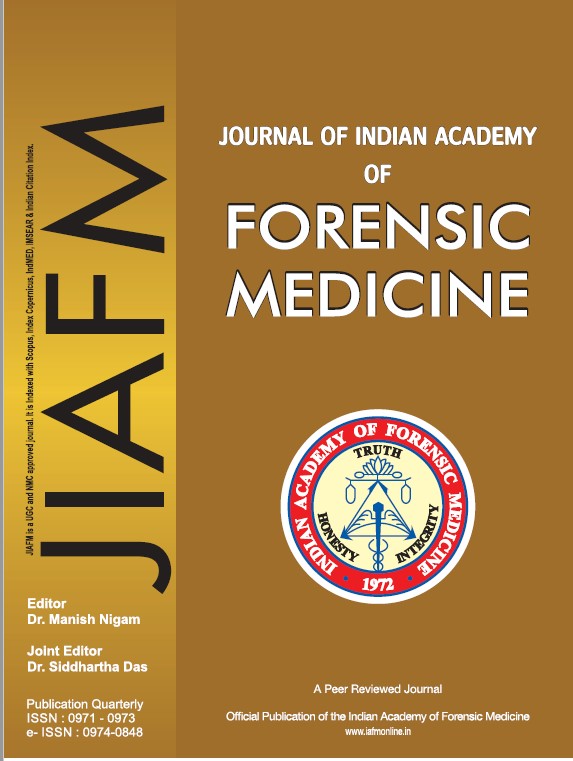Toxicological, Pharmacokinetic and Molecular Properties Prediction by Bioinformatics Tools of Compounds from Cassia Javanica
DOI:
https://doi.org/10.48165/jiafm.2023.45.4.14Keywords:
Cassia javanica, Toxicology, Bioinformatics, EmodinAbstract
To predict the toxicological, pharmacokinetic and molecular properties of certain Cassia javanica compound extracts. This study was investigated on web-based bioinformatics prediction tools with PUBCHEM used for data extraction for authenticated various chemical structural compounds from cassia javanica followed by validation of chemical formula. The 2-dimensional structures are further converted to 3-dimensional (3D) structure with CHEMSKETCH software, the derived 3D structures are then screened for molecular and pharmacokinetic properties such as absorption, distribution, metabolism, elimination. The toxicological profiling for cardiac, respiratory, hepatic, carcinogenicity and mutagenicity is analyzed through toxicophore bioinformatics analysis of Cassia javanica chemical structures. The reports are analyzed and predicted for possible toxicological and drug like compound in extract of cassia javanica. The results obtained indicate that the compounds ent-Epiafzelechin (4alpha-8) epiafzelechin, ent-Epiafzelechin (4alpha-8) epicatechin and Emodin (1,3,8-trihydroxy-6-methylanthracene-9,10-dione) had the druglikeness score −0.93, −0.05, + 0.93, and +0.74, respectively. On acute toxicity prediction, quercetin belonged to Class II and other compounds belonged to Class III. The study predicts emodin had druglikeness pharmacokinetic but unfavourable toxicological profile compared to ent-Epiafzelechin-(4alpha-8)- epiafzelechin and ent-Epiafzelechin-(4alpha-8)-epicatechin.
Downloads
References
Mahesh B, Satish S. Antimicrobial Activity of Some Important Medicinal Plant against Plant IJSER and Human Pathogens. World J Agric Sci. 2008;4:839-843.
Mahesh B, Satish S. Antimicrobial Activity of Some Important Medicinal Plant against Plant IJSER and Human Pathogens. World J Agric Sci. 2008;4:839-843.
Dar RA, Shahnawaz M, Qazi PH.General overview of medicinal plants: a review. J. Phyto. Pharmacol.2017; 6: 349–351.
Lavanya B, Maheswaran A, Vimal N, Vignesh K, Uvarani KY, Varsha R. An overall view of cassia species phytochemical constituents and its pharmacological uses. Int J Pharma Sci Res. 2018;3:2455–2468.
Joshi KC, Tholia MK and Sharma T. Chemical examination of Cassia javanica. Planta Med. 1975; 28(2): 190-2.
Fan Y, Cheng M, Cheng Y .The reformation in our organic chemistry classes caused by the excellent software ACD/ chemsketch. J Guangzhou Univ. 2002; 6:12-32.
Daina, O. Michielin, V. Zoete. Swiss ADME: a free web tool to evaluat pharmacokinetics, drug-likeness and medicinal chemistry friendliness of small molecules. Sci. Rep. 2017; 7: 42-717.
Cardozo T, Totrov M, and Abagyan R. "Homology modeling by the ICM method". Proteins. 1995; 23: 403-414.
Kutner MH, Nachtsheim CJ, Neter J, and Li W. Applied Linear Statistical Models. New York: McGraw-Hill; 2004. p112-124.
Kumavat UC, Shimpi SN and Jagdale SP. Hypoglycemic activity of Cassia javanica Linn. in normal and streptozotocin-induced diabetic rats. J Adv Pharm Technol Res. 2012;3(1): 47–51.
El-Gendy MMA. In vitro evaluation of medicinal activity of Egyptian honey from different floral sources as anticancer and antimycotic infective agents. J Microbial Biochem Technol. 2010; 2:118-123.
Punyasiri PAN, Tanner GJ, Abeysinghe ISB and Kumar V, Campbell PM and Pradeepa NHL. Exobasidium vexans infection of Camellia sinensis increased 2, 3-cisisomerisation and gallate esterification of proanthocyanidins.
Phytochemistry. 2004; 65:2987-2994.
Cheng HY, Yang CM, Lin TC, Shieh DE, Lin CC . ent Epiafzelechin-(4α8)epiafzelechin extracted from Cassia javanica inhibits Herpes Simplex Virus Type 2 replication. J Med Microbiol. 2006; 55(2): 201-6.
Liu C, Fan H, Li Y, Xiao X. Research Advances on Hepatotoxicity of Herbal Medicines in China. Biomed Res Int. 2016;2016:7150391.


